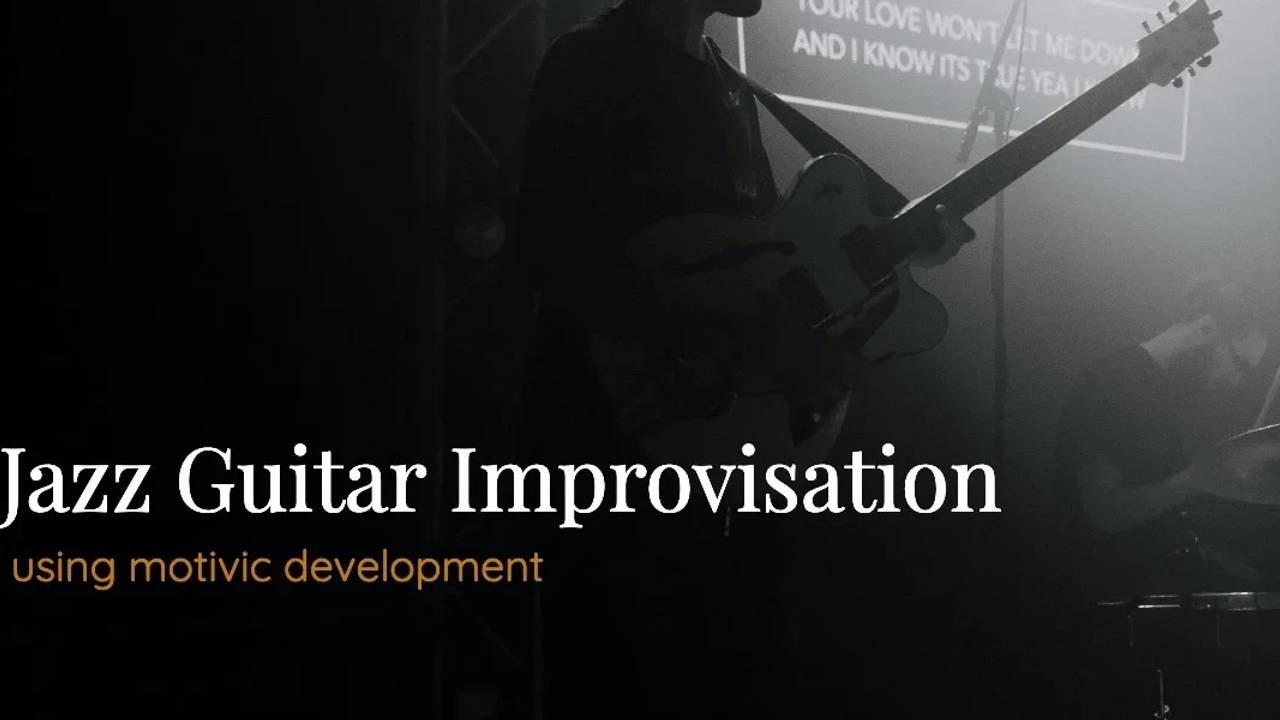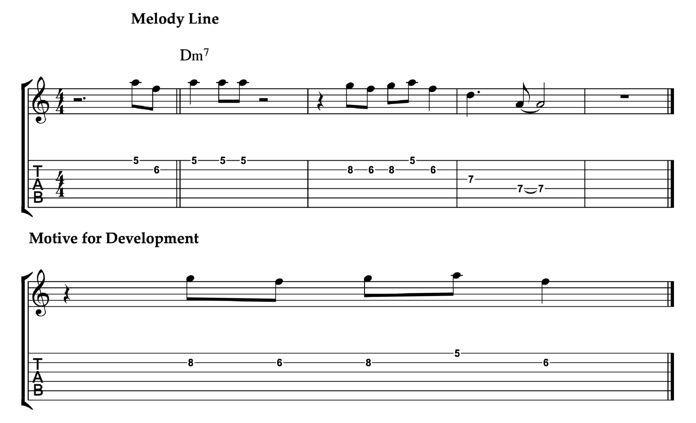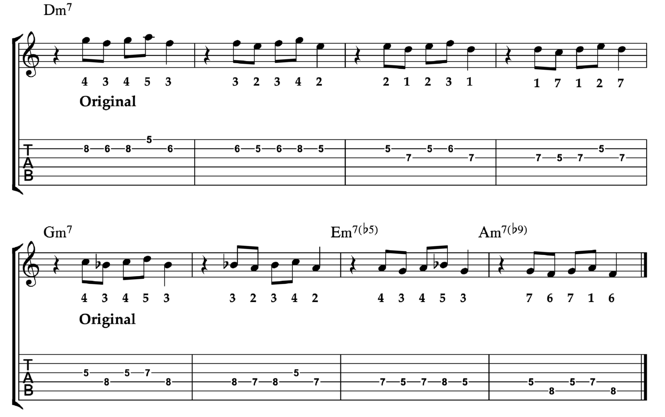
Jazz Guitar Improvisation Using Motivic Development
Apr 30, 2021Guest Lesson by Matt Warnock
I want to start by saying thanks to Marc-Andre Seguin for inviting me to publish a guest post about jazz guitar improvisation on his very cool and informative jazz guitar website.
One of the most often asked questions I get from my students, readers, and guitarists around the world, and of all stages of development is, "How do I develop motives in my solos so that I play more melodic and less scalular?"
Learning to build jazz guitar improvisation off of a motive is a great skill to have as a player. If you can learn to focus on one idea for a long period of time while keeping the audience's attention and building energy in your lines, then when you do step off into a more technical idea such as a long scale run or chromatic substitution, the contrast is much more powerful and ear-grabbing than if you just played longer, scale-based lines throughout your jazz guitar improvisation.
In this article we will learn how to choose a good motive for development in your jazz guitar improvisation, as well as learn three different ways to vary a motive in your solo, providing you with enough variations to keep your line interesting as you focus on one idea for a chorus or more in your solos.
Choosing a Motive
The first thing you'll need to do when working from a motive in your jazz guitar improvisation is to choose one to focus on in your playing. For me, the best place to look is the tune itself, as most jazz standards will offer you enough melodic material to fill dozens of choruses of solos if you know where to look.
For this article, I will use the tune "Summertime" as an example. Below you see the first four bars of the melody line written out in notation and tab. When choosing a motive to work within your solos, you want to pick one that has enough notes that it will be interesting, but not too many that it is hard to manipulate during your lines and phrases.
For me, the line in bar 2 provides the perfect motive to develop further during a jazz guitar improvisation. It is short, 1 bar long. It has three different notes, allowing the listener to easily recognize it but also provide you with enough material to take it in many different directions. And it is built from a single scale, D Minor Pentatonic, which makes it easy to transpose and add chromatic notes later on as you dig deeper into your variations of this motive.
If you are looking to explore this tune further, check out my article "Summertime: Anatomy of a Tune" for a detailed breakdown of the melody, harmony, and improvisational aspects of this classic standard.

Variation 1: Transposition
Now that you have chosen which melody you want to focus on during your solo, we can look at the first type of melodic variation, transposition. Transposition is the act of either moving a motive around the diatonic scale, as you will see in the first four bars below, or altering it to fit a new chord in the progression, as you will see in the second four bars below.
Diatonic Transposition
The first thing you will need to do with your motive in order to quickly transpose it diatonically is to look at it from an intervallic perspective. This motive has five notes, and they are built with the following intervals over the Dm7 chord from which it was taken:
Dm7 = 4-3-4-5-3
This means that you can use the following steps in order to move this motive around the diatonic scale, in this case, D Dorian.
- Pick a new note to start it on, so any note but the 4th, G.
- From that note, say the F in bar 2 below, move one scale note down, E.
- Move back to the first note of the motive, F.
- Climb one note higher, G.
- Return to the second note of the motive, F.
If you do this, you are reconstructing the motive on a different note in the scale, but keeping the same "melodic shape" of the idea. Here are the two ideas side-by-side, starting on G and F.
G-F-G-A-F or 4-3-4-5-3
F-E-F-G-E or 3-2-3-4-2
So you can see that you have kept the same shape for your motive, but have simply moved each note in the original motive down by one scale tone.
Take a look at bars three and four in the example below to see this jazz guitar improvisation idea used to move the motive to the second and root notes of the scale by applying the exact same process. Once you have the hang of it, try taking it to other notes of the D Dorian scale, keeping the same melodic structure, but beginning on different notes in the scale.
Transposition to Other Chords
You can also take the original motive and play it on different chords throughout the tune. To do this, you need to know the scale numbers for the original motive, 4-3-4-5-3 in this case, and then you play those same numbers on the new chord.
So, if you have 4-3-4-5-3 over Dm7 that gives you the notes, G-F-G-A-F. Then, if you want to play this motive over Gm7 in bar 5, you find the 4, C, and repeat the same order of notes. So, 4-3-4-5-3 of Gm7 produces the notes C-Bb-C-D-Bb.
You can also see this approach in bar 7 below where I played the original lick over Em7b5, producing the notes A-G-A-Bb-G.
For the last two bars, 6 and 8, I used a transposition of the original motive over Gm7 and then again over A7b9.
If you are new to this idea, you might want to stick to playing the original motive over each chord a number of times, until you can do it on the spot. When you are comfortable, you can practice transposing the original motive around the diatonic scales for each chord in the progression, such as I did in bars 6 and 8.
Being able to see how a motive is built, transpose it around a diatonic scale, and be able to transpose it to other chords in a progression are invaluable skills that will allow you to focus on a motive for long periods of time, keeping it in your lines regardless of chord or key movement in the tune.

Variation 2: Rhythmic Alteration
The next idea you can check out when developing a motive in your playing is rhythmic alteration. In this concept, you take the original jazz guitar improvisation motive and then alter the rhythm by doing one of three things.
Elongate: This is where you extend the rhythms for the original motive so that it is longer and covers more ground time-wise in the tune. You can see this in bars 2 and 3 of the example below.
Compress: Here, you shrink the motive so that it is shorter rhythmically and covers a smaller section of the tune. You can see this idea in bar 4 of the example below.
Rhythmic Transposition: With this concept, you can either stick to the original rhythmic grouping exactly, as in bar 5 and simply start the motive on a different beat in the measure. Or, you can alter the motive by elongating or compressing some or all of it and then starting that new idea on a different beat in the measure.
Either way, the goal is to keep the original idea in the ears of the listener, but alter the rhythm so that it doesn’t become stale and boring as you work it through the tune.

Variation 3: Chromatic Approach Notes
The last melodic variation we will check out is the concept of adding chromatic approach notes to your lines. This idea is relatively simple. For any note in your original motive, you can add one chromatic note above, one chromatic note below, or both when varying this idea in your solos.
In the short example below, you can see where I added these extra notes to spice up the line. You will notice that sometimes a chromatic note below a melody note will come from the scale, such as the E in bar 6 below the F.
Though this note does come from the Gm7 scale, try and think of these as chromatic below or above the notes in your motive.
This way you will continue to build your ideas based on the jazz guitar improvisation motive you are working on rather than scales or arpeggios, which are cool but may not be the best fit in a situation like this.

Learning to choose and then develop a memorable motive from the melody of a tune can not only provide you with a plethora of musical inspiration in your lines, but can also build a deep connection with your audience as you lead them through your jazz guitar improvisation solos rather than play over top of them with your lines.
Check out these exercises over "Summertime," or any other jazz tune in the woodshed this week. And, when you're ready bring these concepts into the jam room or out on the bandstand. There's nothing fancy about working on a motive over a number of choruses in your jazz guitar improvisation, but the positive reaction you get from your band-mates and audience just might surprise you.
About the Author
Matt Warnock is the owner of www.mattwarnockguitar.com, a free website that provides hundreds of lessons and resources designed to help guitarists of all experience levels meet their practice and performance goals. Matt currently lives in the UK where he is a Senior Lecturer at the Leeds College of Music and an examiner for the London College of Music (Registry of Guitar Tutors).









